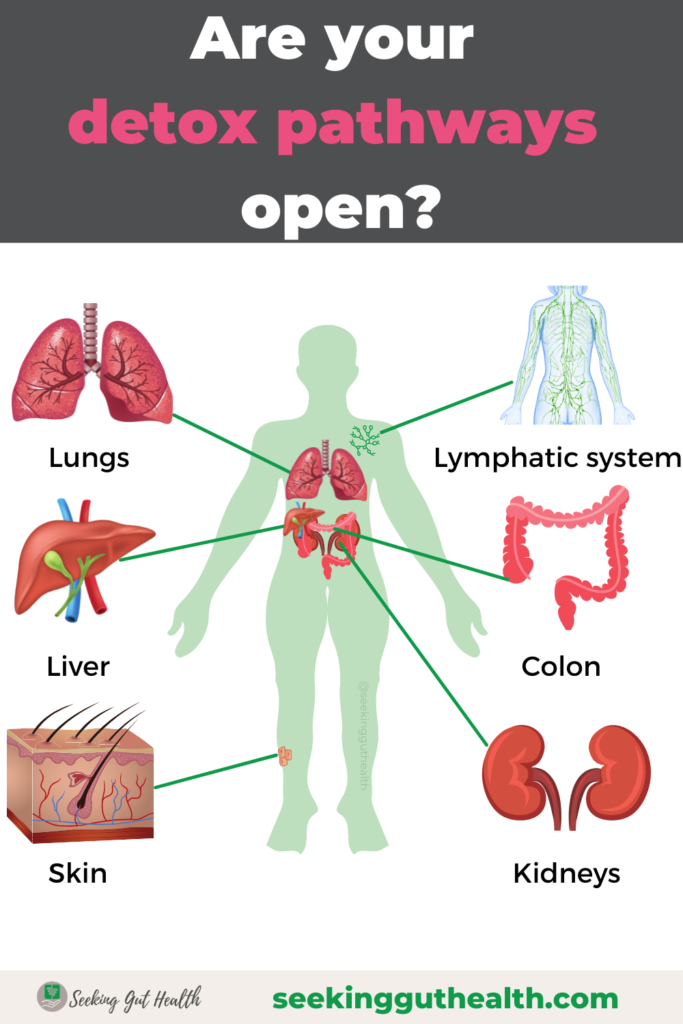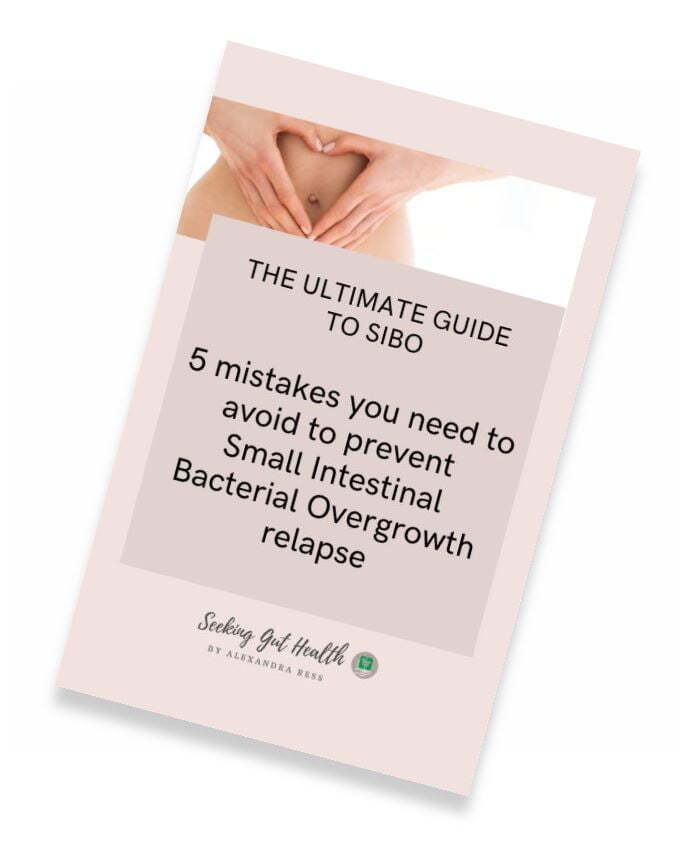Opening your detox pathways is crucial for your health and in any clearing protocol
I see many people in the SIBO (Small Intestinal Bacterial Overgrowth) or even anti-Candida, parasite world ready to quickly jump on an antimicrobial/antibiotics or antifungal route and bombard their body with heavy herbs or medication to get rid of the problem as soon as possible.
I understand that we live in a fast-paced world and constantly search for instant solutions, but everything has a specific sequence. Ignoring our body’s function can cause more harm than good. One of these functions is the detoxification process.
Harmful components can get into our body from outside (exogenous sources) via radiation, heavy metals, mycotoxins, pesticides, herbicides, medications/drugs, plastics, and the list is almost endless nowadays. But the toxins can be produced inside our body (endogenous sources); they can be the byproducts of intestinal microorganisms, excess hormones, intermediary metabolites, free radicals, etc.
Over long periods, these daily contaminants may have a cumulative effect and burden our detoxification process that may eventually lead to impaired function or disease. (1)
Supporting the detox pathways (lungs, kidneys, skin, colon, liver/ gallbladder, lymphatic system) are crucial to eliminate harmful compounds and reduce any possible (die-off) symptoms. We can release toxins through respiration, sweat, urine, and stool.

Let's check some of these detox pathways:
THE COLON
One of the most crucial pathways in the colon or large intestine. If you are constipated, then toxins can get stuck in your body. Doing any clearing phase without opening this elimination channel is a huge mistake! You need to poop every day (better to do so at least twice a day) before doing any treatment! (2)
You can help move your bowels and flush the toxins by:
- drinking enough fluid a day, preferably filtered water to hydrate your body (3)
- eating fiber-rich fruits and vegetables, which can add bulk to the stool (4)
- moving your body regularly (5)
- using herbal remedies to stimulate the intestines such as ginger root or aloe vera leaf (6)(7)
- doing colonics, enemas
THE LIVER & BILE FLOW
The other vital organ is your liver. The liver is the primary detox organ that filters toxins, metabolizes nutrients, breaks down fat, manages carbohydrate metabolism, produces bile, and does many more functions. (8)
Bile also has many essential roles: it helps fat digestion, controls thyroid hormones, cholesterol, motility, and moves toxins out of the liver. In addition, it has a crucial antimicrobial effect that can control the overgrowth of bacteria in the small intestine. (9) Slow or blocked bile flow can be problematic as toxins cannot be transported out, leading to more die-off reactions. Several symptoms may indicate that your bile flow is diminished: reflux symptoms, gallstones, pale-colored & greasy stool, pain under the ribs on the right side, headaches, fatigue.
Various factors can contribute to poor bile flow. For example, women with hypothyroidism (an underactive thyroid gland) may also have decreased bile flow. This is because bile breaks down the fat necessary to generate thyroid hormone. (10) Other factors can be infections (parasites, virus, bacteria) (11), (12), certain medications, excess estrogen (13).
Promoting liver health and bile production can support the detox routes. The followings can support this elimination channel:
- Milk thistle (Silymarin) has been used for centuries to protect the liver cells from damage (14)
- Dandelion leaf and lemon balm have a positive effect on the liver due to their antioxidant and anti-inflammatory properties (15)
- Coffee enemas are used for detox for a long time by helping the body release bile (16)

THE LYMPHATIC SYSTEM
The lymphatic system may also need attention, especially that it requires an extra pump to move it in contrast to the cardiovascular system. The lymphatic system keeps the balance of fluid between the blood and tissues and plays a key role in the immune system, reacting to any bacteria, toxins, or viruses. (17)
Signs that you might have lymph issues: swelling, edema ( especially: face, belly (bloating), hands, ankles), cellulite, hard nodules along neck, underarm, groin; swollen breast tissues, constipation, etc.
You can achieve better lymph flow by doing:
- Movement: Rebounding, Yoga
- Deep belly breathing
- Hot & Cold showers
- Sauna
- Dry brushing
- Massages
THE KIDNEYS
The kidneys filter your blood and eliminate toxins from your body through urine. Proper hydration is vital to guarantee that everything is running smoothly. Low water intake may lead to low urine volume, contributing to crystallization and eventually kidney stones in some individuals.
The Institute of Medicine recommends an average daily fluid consumption of 3.7 liters for males and 2.7 liters for women. But, of course, individual needs and habits may influence the required daily amount.
Other things such as brown seaweed extract (18), lemon juice, dandelion (19), parsley, pomegranate, and stinging nettle (20) may assist the kidneys in producing more urine, and that in turn may help get rid of waste.
Imagine taking back control of your body and living bloat-free. Download your free guide and learn the 5 MISTAKES you need to AVOID TO PREVENT SMALL INTESTINAL BACTERIAL OVERGROWTH RELAPSE.
Grab your copy today!
THE LUNGS
Air pollution is real and affects all of us. According to the WHO: “ Air pollution kills an estimated seven million people worldwide every year.” We inhale toxins, dust, smoke, dirt, pollen, and many kinds of pollutants. A steady stream of pollutants in the air over time may harm the respiratory system and make it difficult to breathe.
There are several ways to clean the paths to the lungs and help them get rid of toxins:
- Getting an air purifier to improve the quality of air around you
- Remove artificial scents such as air fresheners, scented candles – use essential oils instead
- Exercise can help you get more oxygen to the cells, especially useful is to do some deep breathing exercise
- Spend time regularly at the beach or visit a salt cave to inhale salty air (halotherapy) to improve lung function (21)
THE SKIN
The skin is the largest organ in the body that can mirror our internal health. Therefore, any inflammation in the body can affect the skin, causing breakouts, acne, eczema, or even more severe skin issues. Nowadays, you can find many products designed for “skin detox” and skin issues, but they will rarely solve the root cause that might stem from the inside.
But your skin also can eliminate toxic substances via sweating. Sauna is a great way to mobilize toxins from the fat, which can be released in sweat or sent to the liver for detoxification. (22) This way, the body can eliminate chemical solvents, heavy metals, pesticides, etc. (23) You can also induce the detox process by doing facial streams. That way, you can open the pores, release toxins and dirt.
The best prevention you can do is check your current skincare products and routine and get rid of the toiletries, cosmetics that contain harmful chemicals such as parabens, BHT, phthalates, Formaldehyde, etc.
The bottom line
Your body has its detoxification and biotransformation process to get rid of toxins. There are several elimination channels, but you need to ensure that these detox pathways are open and working correctly, so nothing gets stuck in the system. This can be especially crucial if you are undergoing any clearing phase to avoid die-off symptoms.
Some herbs, techniques can help increase the effectiveness of the detoxification process, but nothing can beat a good foundation for optimal health & wellness. Hydration, a healthy diet, regular exercise, good quality sleep are the basis for a well-functioning body.
*This post is only for informational purposes; and not meant to diagnose or treat any disease. I advise consulting with your healthcare practitioner regarding any treatment options or dietary changes.
- Silins, I., & Högberg, J. (2011). Combined toxic exposures and human health: biomarkers of exposure and effect. International journal of environmental research and public health, 8(3), 629–647. https://doi.org/10.3390/ijerph8030629
- Andrews, C. N., & Storr, M. (2011). The pathophysiology of chronic constipation. Canadian journal of gastroenterology = Journal canadien de gastroenterologie, 25 Suppl B(Suppl B), 16B–21B.
- Boilesen, S. N., Tahan, S., Dias, F. C., Melli, L., & de Morais, M. B. (2017). Water and fluid intake in the prevention and treatment of functional constipation in children and adolescents: is there evidence?. Jornal de pediatria, 93(4), 320–327. https://doi.org/10.1016/j.jped.2017.01.005
- Yang, J., Wang, H. P., Zhou, L., & Xu, C. F. (2012). Effect of dietary fiber on constipation: a meta analysis. World journal of gastroenterology, 18(48), 7378–7383. https://doi.org/10.3748/wjg.v18.i48.7378
- Gao, R., Tao, Y., Zhou, C., Li, J., Wang, X., Chen, L., Li, F., & Guo, L. (2019). Exercise therapy in patients with constipation: a systematic review and meta-analysis of randomized controlled trials. Scandinavian journal of gastroenterology, 54(2), 169–177. https://doi.org/10.1080/00365521.2019.1568544
- Nikkhah Bodagh, M., Maleki, I., & Hekmatdoost, A. (2018). Ginger in gastrointestinal disorders: A systematic review of clinical trials. Food science & nutrition, 7(1), 96–108. https://doi.org/10.1002/fsn3.807
- Hong, S. W., Chun, J., Park, S., Lee, H. J., Im, J. P., & Kim, J. S. (2018). Aloe vera Is Effective and Safe in Short-term Treatment of Irritable Bowel Syndrome: A Systematic Review and Meta-analysis. Journal of neurogastroenterology and motility, 24(4), 528–535. https://doi.org/10.5056/jnm18077
- org [Internet]. Cologne, Germany: Institute for Quality and Efficiency in Health Care (IQWiG); 2006-. How does the liver work? 2009 Sep 17 [Updated 2016 Aug 22]. Available from: https://www.ncbi.nlm.nih.gov/books/NBK279393/
- Zhou, H., & Hylemon, P. B. (2014). Bile acids are nutrient signaling hormones. Steroids, 86, 62–68. https://doi.org/10.1016/j.steroids.2014.04.016
- Watanabe, M., Houten, S. M., Mataki, C., Christoffolete, M. A., Kim, B. W., Sato, H., Messaddeq, N., Harney, J. W., Ezaki, O., Kodama, T., Schoonjans, K., Bianco, A. C., & Auwerx, J. (2006). Bile acids induce energy expenditure by promoting intracellular thyroid hormone activation. Nature, 439(7075), 484–489. https://doi.org/10.1038/nature04330
- Gupta, E., & Chakravarti, A. (2008). Viral infections of the biliary tract. Saudi journal of gastroenterology : official journal of the Saudi Gastroenterology Association, 14(3), 158–160. https://doi.org/10.4103/1319-3767.41740
- Ha, J. S., Choi, H. J., Moon, J. H., Lee, Y. N., Tae, J. W., Choi, M. H., Lee, T. H., & Cha, S. W. (2015). Endoscopic Extraction of Biliary Fascioliasis Diagnosed Using Intraductal Ultrasonography in a Patient with Acute Cholangitis. Clinical endoscopy, 48(6), 579–582. https://doi.org/10.5946/ce.2015.48.6.579
- Cirillo, D. J., Wallace, R. B., Rodabough, R. J., Greenland, P., LaCroix, A. Z., Limacher, M. C., & Larson, J. C. (2005). Effect of estrogen therapy on gallbladder disease. JAMA, 293(3), 330–339. https://doi.org/10.1001/jama.293.3.330
- Gillessen, A., & Schmidt, H. H. (2020). Silymarin as Supportive Treatment in Liver Diseases: A Narrative Review. Advances in therapy, 37(4), 1279–1301. https://doi.org/10.1007/s12325-020-01251-y
- Choi, B. R., Cho, I. J., Jung, S. J., Kim, J. K., Park, S. M., Lee, D. G., Ku, S. K., & Park, K. M. (2020). Lemon balm and dandelion leaf extract synergistically alleviate ethanol-induced hepatotoxicity by enhancing antioxidant and anti-inflammatory activity. Journal of food biochemistry, 44(8), e13232. https://doi.org/10.1111/jfbc.13232
- Kim, E. S., Chun, H. J., Keum, B., Seo, Y. S., Jeen, Y. T., Lee, H. S., Um, S. H., Kim, C. D., & Ryu, H. S. (2014). Coffee enema for preparation for small bowel video capsule endoscopy: a pilot study. Clinical nutrition research, 3(2), 134–141. https://doi.org/10.7762/cnr.2014.3.2.134
- Moore, J. E., Jr, & Bertram, C. D. (2018). Lymphatic System Flows. Annual review of fluid mechanics, 50, 459–482. https://doi.org/10.1146/annurev-fluid-122316-045259
- Motshakeri, M., Ebrahimi, M., Goh, Y. M., Othman, H. H., Hair-Bejo, M., & Mohamed, S. (2014). Effects of Brown Seaweed (Sargassum polycystum) Extracts on Kidney, Liver, and Pancreas of Type 2 Diabetic Rat Model. Evidence-based complementary and alternative medicine : eCAM, 2014, 379407. https://doi.org/10.1155/2014/379407
- Clare, B. A., Conroy, R. S., & Spelman, K. (2009). The diuretic effect in human subjects of an extract of Taraxacum officinale folium over a single day. Journal of alternative and complementary medicine (New York, N.Y.), 15(8), 929–934. https://doi.org/10.1089/acm.2008.0152
- Nirumand, M. C., Hajialyani, M., Rahimi, R., Farzaei, M. H., Zingue, S., Nabavi, S. M., & Bishayee, A. (2018). Dietary Plants for the Prevention and Management of Kidney Stones: Preclinical and Clinical Evidence and Molecular Mechanisms. International journal of molecular sciences, 19(3), 765. https://doi.org/10.3390/ijms19030765
- Barber, D., Malyshev, Y., Oluyadi, F., Andreev, A., & Sahni, S. (2020). Halotherapy for Chronic Respiratory Disorders: From the Cave to the Clinical. Alternative therapies in health and medicine, AT6413. Advance online publication.
- Krop J. J Alt and Compl Med. 1998;4(1): 77-86
- Schnare DW, Ben M, Shields MG. Body burden reductions of PCBs, PBBs, and chlorinated pesticides in human subjects. Ambio 1984;13: 378-380

Alexandra is a Functional Medicine Certified Health Coach & Holistic Nutritionist specializing in IBS, SIBO, and Gut Health. She helps her clients identify the root causes of their chronic gut issues with functional testing, supporting their bodies holistically and implementing the necessary lifestyle changes long-term to regain control of their bodies and enjoy food freedom. Book your FREE SIBO Assessment call now >>>

